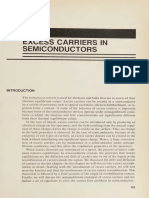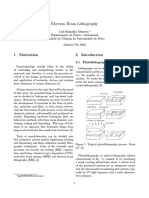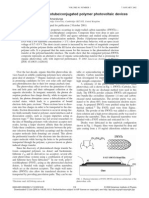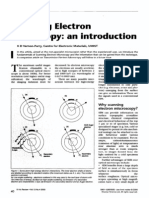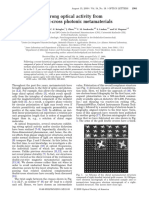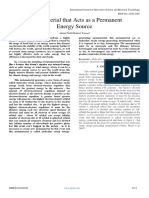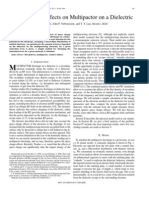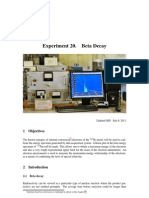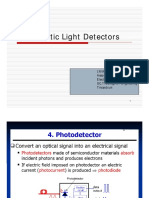Professional Documents
Culture Documents
Energy Spectrum of Converters and Positron Range Estimation in PET Simulation For 511-KeV Photons
Original Title
Copyright
Available Formats
Share this document
Did you find this document useful?
Is this content inappropriate?
Report this DocumentCopyright:
Available Formats
Energy Spectrum of Converters and Positron Range Estimation in PET Simulation For 511-KeV Photons
Copyright:
Available Formats
Volume 8, Issue 2, February – 2023 International Journal of Innovative Science and Research Technology
ISSN No:-2456-2165
Energy Spectrum of Converters and Positron Range
Estimation in PET Simulation For 511-keV Photons
Muhammad Afzaal Sadaqat1 and Dr. Ijaz Ahmed2
1,2
Riphah International University. I-14 Hajj Complex,
Islamabad, Pakistan
Abstract:- The purpose of this study was to observe the Herein, we used Geant4 to simulate the energy
energy distribution of incident 511-keV photons distribution of 511-keV photons for various electrode
produced as a result of annihilation effect e -+e+ γ+γ in materials. The Geant4 simulation package was designed
three different electrodes (of aluminum, glass, and specifically for the passage of charged particles through
Bakelite). The transmission, absorption, and reflection of matter. Ionization and excitation of gas molecules result in
particles for 511-keV photons were examined using a energy losses in charged particles, and the type of
thin or thick layer of electrodes. Moreover, the manner interaction determines the cross-section of the energy loss.
in which the energy spectrum of a single electrode The total energy loss is depicted in the following equation
changes with its thickness was explored. The positron [3].
range of the positron emission tomography (PET)
radioisotopes is responsible for the production of high- -1/ρdE/dx|col=CNA/A[lnπ2γ3(mec2 )2/I2 – a] (1)
quality images in (PET) imaging reconstruction. As a
result, the ranges and kinetic energies of positrons from Here, ‘ρ’ is the density of the particles, ‘dE/dx’ is the
three radioisotopes (F18, O15, I124) were calculated in this energy loss, and ‘C’ is a constant expressed in MeV/cm 2.
study using the Geant4 application for tomographic For electrons a=2.9 and positrons a=3.6. 'I’ represents the
emission (GATE) simulation package. Notably, the intensity, ‘me’ represents the mass of electrons, and ‘A’ is the
mass number of the absorbing material.
ranges thereof were determined via their
energies.Finally, the simulated ranges and kinetic energy In the second part of this study, we used GATE to
values were compared with the literature values estimate the ranges and kinetic energies of positrons of F18,
revealing a 0.5% difference. O15, and I124 radionuclides in PET simulations for the case of
Keywords:- Annihilation effect, Positron Emission 511-keV photons.
Tomography (PET), Imaging reconstruction, Radioisotopes. II. ENERGY DISTRIBUTION OF 511-KEV
I. INTRODUCTION PHOTONS
The growing interest in positron emission tomography Geant4 was used to examine the energy spectrum
(PET) in medical imaging reconstruction has facilitated formed upon incidence 511-keV photons on various
development of techniques allowing healthcare electrodes. Fig. 1 depicts an image of the energy deposited
professionals to see inside a patient’s body without directly on three different electrodes as a result of this simulation.
looking at a camera or performing an open surgery and Because of the photoelectric effect, the rate of energy
forming qualitative images. PET is currently the most deposition abruptly decreases at 340-keV photon energy.
preferred imaging method in clinical research. Short-lived The low electrical resistivity of aluminum (10-8Ω-cm)
radionuclides are endowed with subjective tissue that emits implies a lower resistance offered to incoming photons than
positrons at a time based on their respective half-lives in this of glass and Bakelite. As a result, there existed more events
procedure. This positron travels some distance (~mm) in a in which energy was deposited takes place at the electrode.
tissue before it annihilates with an electron to produce two
back-to-back 511-keV photons traveling at 180o to each
other. In this regard, an activity distribution in a tissue can
be created by aggregating several interaction events [1].
PET is noninvasive imaging technique, used in tomography
for small animals, that involves good time resolution, a
potentially high spatial resolution, and low cost [2].
IJISRT23FEB461 www.ijisrt.com 953
Volume 8, Issue 2, February – 2023 International Journal of Innovative Science and Research Technology
ISSN No:-2456-2165
Fig 1: Energy deposited at absorber dN/ Kinetic Energy at Exit dN/dE
Fig 2: Transmitted Compton Electrons Kinetic
Fig. 2 depicts the kinetic energy of the transmitted on the energy of the transmitted Compton electrons.
Compton electron at the exit point. Electron extraction from Moreover, energy fluctuations up to 240-keV occur for
an electrode reveals that there is no electrical resistive effect transmitted Compton photons 9 (Fig. 3).
Fig 3: Transmitted Compton Photon Kinetic Energy at Exit dN/dE
Fig 4: Reflected Compton Photon Kinetic Energy at Exit dN/De
IJISRT23FEB461 www.ijisrt.com 954
Volume 8, Issue 2, February – 2023 International Journal of Innovative Science and Research Technology
ISSN No:-2456-2165
Because photons are produced at energies lower than electrode are depicted in Fig. 5. Because, electrons produce
this, by the photoelectric effect or multiple scattering [1]. intense ionization in the gas gap and cause avalanches at
Photons are scattered at 90° at 240-keV energy, but the higher energies, the probability rate decreases with energy;
probability rate increases at higher energy. The maximum there are very few events at higher energy.
probability of Compton photons can be seen at a very high
energy (~ 511 keV). Fig. 6 depicts the kinetic energy of the transmitted
Compton electrons and Compton photons for the Bakelite
Because of the thinness of the electrode material (2 electrode. Because of the photoelectric effect, the
mm), one out of every ten events in which incident photons probability of events for Compton electrons decreases at
with energies of 180 keV leave the crystal without 340-keV photon energy. The curve fluctuates up to photon
interacting and are thus scattered on the electrode entrance energy of 240-keV for transmitted Compton photons.
window is shown in Fig. 4. Backscattered particles are Photons with energies less than 240-keV are produced as a
thought to be very important in the simulation of single- result of the photoelectric effect or multiple scattering.
layer crystals with sufficient dimensions and their scattering Photons are scattered at 90o at 240 keV, resulting in a longer
properties [4]. The energy deposition and energy of path through the solid material before reaching the gas
Compton electrons and Compton photons for the aluminum volume [1].
Fig 5: Energy spectrum of Compton electrons Compton photons absorbed and at creation of aluminum electrode.
Fig 6: Transmitted Compton electrons and Compton photons kinetic energy at exit.
However, owing to the thinness of the glass electrode window (Fig. 7). The reflected Compton electrons have a
material (~2mm), 70% of the incident photons leave the low speed and high ionizing ability; therefore, the rate of
crystal without interacting and may enter the glass electrode reflection is extremely low [4].
IJISRT23FEB461 www.ijisrt.com 955
Volume 8, Issue 2, February – 2023 International Journal of Innovative Science and Research Technology
ISSN No:-2456-2165
Fig 7: Reflected Compton electrons and Compton photons kinetic energy at exit
III. VARIATION OF ENERGY DISTRIBUTION electrons at creation remains constant (Fig 8 a,c,d)).
WITH ELECTRODE THICKNESS Notably, only the probability of transmission of the
Compton photons increases with electrode thickness (Fig 8
Further, we checked the alteration of the energy b). As a result, the greater is the probability of transmission
spectrum curves at the end of this process by changing the of Compton photons, the higher is the electrode material
thickness of the electrode (aluminum). Upon variation of the thickness.
thickness, the probability of transmitted Compton electrons,
energy deposited at the absorber, and energy of the Compton
(a) (b)
(c) (d)
Fig. 8: Variation of energy spectrum with electrode thickness (a) transmitted Compton electrons (b) transmitted Compton photons
(c) energy deposited at absorber (d) Compton electrons energy at creation
IJISRT23FEB461 www.ijisrt.com 956
Volume 8, Issue 2, February – 2023 International Journal of Innovative Science and Research Technology
ISSN No:-2456-2165
IV. ESTIMATION OF POSITRON RANGE AND (2), one can estimate the mean and maximum value of the
KINETIC ENERGY positron's range.
The positron travels a certain distance in the tissue r = √x2+y2+z2 (2)
before annihilating into two photons. This is the distance
between the point of emission and the point of annihilation where, r represents the range, moreover, x, y, and z are
in Euclidean space and represents a significant advancement the position vectors of the range along the x, y, and z-axis
in PET imaging blurring. Blurred images are considerably respectively. Notably, their energies determined their ranges,
improved during imaging reconstruction through accurate and fluorine's positrons were found to be short-range ones
estimation of the positron range. We estimated the positron (~2mm) whereas, iodine’s positronswere found to be long-
range for three commonly used PET radioisotopes F18, O15, range ones (~10mm). The spatial resolution of the image can
and I125 using the GATE simulation toolkit. These be improved by using short half-lived radionuclides. As a
radioisotopes are found in a variety of biological media result of its short half-life, short positron range, and better
including striated muscle, brain, soft bone, water, lung, spatial resolution, fluorine is the most frequently used
adipose tissue, cortical bone, and skin [6]. We compared the radioisotope in the PET imaging [5].
GATE simulation results to those found in the literature
(Table 1 and 2) and our findings are observed to be F18 has half life t1/2= 110 min and disintegrates into O18
consistent with those of experiments.In this case, the by β (96.9%) and electron capture (3.1%). The emitted
+
majority of the simulations conducted previously had a positrons have Rmax= 2.3 mm and Rmean= 0.64 mm with the
mean and maximum range discrepancy of less than 20%. corresponding energies Emax= 0.63 MeV and Emean= 0.25
Based on these measurements, we conclude that a more MeV. O15 disintegrates into N15 with a half-life of t1/2= 2 min
accurate simulation setup is required particularly to by β+ (99.9%) and electron capture (0.1%). The range of its
disengage the positronium formation effect in the positron positron emission is Rmax= 8.4 mm and Rmean= 3.0 mm and
range. The spectra of positron range and kinetic energy are its corresponding energies are Emax= 1.73 MeV and Emean=
shown in Fig. 8 and Fig. 9 respectively. Three columns exist 0.73 MeV. Similarly, I124 decays under a long half-life of
in the output text: X(mm), Y(mm), and Z(mm). Each set of 100h into Te124 by β+ (22.7%) and electron capture (77.3%).
points represents the position vector of the range values as Its positron range is calculated as Rmax= 10.2 mm and Rmean=
well as their respective coordinate systems. By accurately 4.4 mm and its corresponding energies are Emax= 2.13 MeV
calculating the norm value of each data set using formula and 0.97 MeV.
Fig. 9: Positron range (mm) Fig. 10: Positron kinetic energy (MeV)
Rmax < R > : Most Probable Range
# Simulation # Data # Simulation # Data
18
F 2.04 mm 2.3 mm 0.43 mm 0.64 mm
15
O 7.2 mm 8.4 mm 4.01 mm 3.0 mm
I124 9.16 mm 10.2 mm 2.34 mm 4.44 mm
Table 1: Positron range (mm)
Emax < E > : Most Probable Energy
# Simulation # Data # Simulation # Data
F18 0.60 MeV 0.63 MeV 0.21 MeV 0.25 MeV
15
O 1.60 MeV 1.73 MeV 0.42 MeV 0.73 MeV
124
I 2.10 MeV 2.13 MeV 0.51 MeV 0.97 MeV
Table 2: Positron kinetic energy (MeV)
IJISRT23FEB461 www.ijisrt.com 957
Volume 8, Issue 2, February – 2023 International Journal of Innovative Science and Research Technology
ISSN No:-2456-2165
V. CONCLUSION
In this study, in the case of incident 511-keV photons,
we observed the manner in which energy is distributed for
three electrode materials: aluminum, glass, and Bakelite.
Compton scattering is thought to be the primary
phenomenon governing interaction with fluctuations of the
energy distribution of Compton photons and Compton
electrons occuring at photon energies of 340 keV. In
addition, we investigated the variation in the energy
spectrum of a single electrode (aluminum) as its thickness
varies. Finally, we extracted certain GATE results that show
the ranges and kinetic energies of positrons for different
radionuclides F18, O15, and I124. The ranges and kinetic
energy values that we simulated for the F18, O15, and I124
radioisotopes resemble the literature values, indicating that
our simulation model is valid.
REFERENCES
[1.] Lippmann, C., Vincke, H., & Riegler, W. (2009).
Simulation of RPC performance for 511 keV photon
detection. Nuclear Instruments and Methods in
Physics Research Section A: Accelerators,
Spectrometers, Detectors, and Associated
Equipment,602(3), 735-739.
[2.] Weizheng, Z., Ming, S., Cheng, L., Hongfang, C.,
Yongjie, S., & Tianxiang, C. (2014). Monte Carlo
Simulation of RPC-based PET with GEANT4.arXiv
preprint arXiv:1402.4544.
[3.] B. Rossi. High Energy Particles. Prentice-Hall, Inc.,
Englewood Cliffs, NJ, 1952.
[4.] Santin, G., Strul, D., Lazaro, D., Simon, L., Krieguer,
M., Martins, M. V., ... & Morel, C. (2003). GATE: A
Geant4-based simulation platform for PET and
SPECT integrating movement and time management.
IEEE Transactions on nuclear science, 50(5), 1516-
1521.
[5.] Conti, M., & Eriksson, L. (2016). Physics of pure and
non-pure positron emitters for PET: a review and a
discussion. EJNMMI Physics,3(1), 1-17.
[6.] Cal-González, J., Herraiz, J. L., España, S., Corzo, P.
G., Vaquero, J. J., Desco, M., & Udias, J. M. (2013).
Positron range estimations with PeneloPET. Physics
in Medicine & Biology, 58(15), 5127.
IJISRT23FEB461 www.ijisrt.com 958
You might also like
- DetectorsDocument282 pagesDetectorsMoch. Syamsul AlamsyahNo ratings yet
- Mitigation of Electron Cloud Effects in The FCC-ee ColliderDocument11 pagesMitigation of Electron Cloud Effects in The FCC-ee ColliderFatihNo ratings yet
- SemiDocument29 pagesSemiDawood NodilNo ratings yet
- GaN 1Document12 pagesGaN 1crisoforoNo ratings yet
- Gao 2016Document6 pagesGao 2016Jorge Daniel Torres AlvarezNo ratings yet
- MPhys Long Report: Gamma-Ray Spectroscopy Using a High-Purirty Germanium DetectorDocument15 pagesMPhys Long Report: Gamma-Ray Spectroscopy Using a High-Purirty Germanium DetectorDavid RayNo ratings yet
- Luis Afonseca Electron Beam LithographyDocument8 pagesLuis Afonseca Electron Beam LithographyLuis AfonsecaNo ratings yet
- Testing The Infrared Light Effect On C-Si PV Cells: Bechara Nehme Tilda AkikiDocument5 pagesTesting The Infrared Light Effect On C-Si PV Cells: Bechara Nehme Tilda Akikianon_829283562No ratings yet
- Modern Physics - TestDocument3 pagesModern Physics - TesttessaNo ratings yet
- Meta Material That Acts As A PermanentDocument8 pagesMeta Material That Acts As A PermanentInternational Journal of Innovative Science and Research TechnologyNo ratings yet
- Single-Wall Carbon Nanotube Conjugated Polymer Photovoltaic DevicesDocument3 pagesSingle-Wall Carbon Nanotube Conjugated Polymer Photovoltaic DevicesSara Raquel Costa PintoNo ratings yet
- The National Academies Press: Airport Passenger Screening Using Backscatter X-Ray Machines: Compliance With StandardsDocument7 pagesThe National Academies Press: Airport Passenger Screening Using Backscatter X-Ray Machines: Compliance With StandardsKaruppasamy Pandian Shanmugavelu ParamasivamNo ratings yet
- SEM IntroDocument5 pagesSEM IntroSayan KarNo ratings yet
- Degradation of Silicon Two-Barrier ThinDocument9 pagesDegradation of Silicon Two-Barrier ThinFakhraddinNo ratings yet
- Improving Electric Energy Result by Using Composition WavelengthDocument5 pagesImproving Electric Energy Result by Using Composition WavelengthDustin WardNo ratings yet
- Interaction of Photons With Matter: Kyoung-Jae ChungDocument36 pagesInteraction of Photons With Matter: Kyoung-Jae ChungSanjuNo ratings yet
- Auger Electron Spectroscopy (AES) PrinciplesDocument63 pagesAuger Electron Spectroscopy (AES) PrinciplesSenthilkumar PragasamNo ratings yet
- THE A: Electrostatic OF Shredded Plastic Mixtures Using Tribo-CycloneDocument30 pagesTHE A: Electrostatic OF Shredded Plastic Mixtures Using Tribo-Cyclonechirag.sanchetiNo ratings yet
- Physics of Gamma Rays in Nuclear MeasurementsDocument29 pagesPhysics of Gamma Rays in Nuclear MeasurementsDadadad dadadadadadNo ratings yet
- Photonics: On The Importance of Electron Beam Brightness in High Gain Free Electron LasersDocument25 pagesPhotonics: On The Importance of Electron Beam Brightness in High Gain Free Electron LasersYu Shu HearnNo ratings yet
- Photoelectric Effect AppDocument9 pagesPhotoelectric Effect AppNitin SharmaNo ratings yet
- Who, Apr 2011Document5 pagesWho, Apr 2011emediageNo ratings yet
- Tremaine 2001 0111Document5 pagesTremaine 2001 0111Particle Beam Physics LabNo ratings yet
- (MIT) The Photoelectric EffectDocument4 pages(MIT) The Photoelectric EffectTVFionnaXQNo ratings yet
- 2015 ZnODocument7 pages2015 ZnOJayakrishnan A RNo ratings yet
- Experimental Studies of Compensation of Beam-Beam Effects With Tevatron Electron LensesDocument34 pagesExperimental Studies of Compensation of Beam-Beam Effects With Tevatron Electron LensesSaliNo ratings yet
- Report For Experiment On Gamma Spectroscopy of Bismuth 207 - Nida Riaz - Alfred MishiDocument27 pagesReport For Experiment On Gamma Spectroscopy of Bismuth 207 - Nida Riaz - Alfred MishiAlfred MishiNo ratings yet
- Strong Optical Activity From Twisted-Cross Photonic MetamaterialsDocument3 pagesStrong Optical Activity From Twisted-Cross Photonic MetamaterialsBaban BaidyaNo ratings yet
- Zhao 2015Document4 pagesZhao 2015Alexander Alfonso AlvarezNo ratings yet
- s0969-806x (01) 00322-x توضیحاتDocument3 pagess0969-806x (01) 00322-x توضیحاتHadi TeymouriNo ratings yet
- Detection of Gamma Radiation: FYSZ460 Syventävien Opintojen LaboratoriotyötDocument19 pagesDetection of Gamma Radiation: FYSZ460 Syventävien Opintojen LaboratoriotyötDUYEN LƯUNo ratings yet
- PairProductionEnergyGermanium RefDocument7 pagesPairProductionEnergyGermanium RefClarettaNo ratings yet
- PhysRevLett 130 205001Document7 pagesPhysRevLett 130 205001PedroNo ratings yet
- Detec Tion of Gamma RadiationDocument19 pagesDetec Tion of Gamma RadiationMelisa IVNo ratings yet
- Beta GammaDocument9 pagesBeta GammaCrazy crack0% (1)
- Meta Material That Acts As A Permanent Energy SourceDocument8 pagesMeta Material That Acts As A Permanent Energy SourceInternational Journal of Innovative Science and Research TechnologyNo ratings yet
- Advanced Space Nuclear Reactors From Fiction To Reality: Space, Propulsion & Energy Sciences International Forum - 2011Document23 pagesAdvanced Space Nuclear Reactors From Fiction To Reality: Space, Propulsion & Energy Sciences International Forum - 2011daniel hogganNo ratings yet
- Electron Range Effects in Focused Electron Beam Induced Deposition of 3D NanostructuresDocument5 pagesElectron Range Effects in Focused Electron Beam Induced Deposition of 3D NanostructuresAtomic IndustryNo ratings yet
- Space-Charge Effects On Multipactor On A Dielectric: Agust Valfells, John P. Verboncoeur, and Y. Y. Lau, Member, IEEEDocument8 pagesSpace-Charge Effects On Multipactor On A Dielectric: Agust Valfells, John P. Verboncoeur, and Y. Y. Lau, Member, IEEEPsyplant PsytranceNo ratings yet
- Gamma Gamma Coincidence PDFDocument20 pagesGamma Gamma Coincidence PDFAnjan DasNo ratings yet
- Ch6 PhotonicDocument11 pagesCh6 PhotonicZeyad AymanNo ratings yet
- Ijetr022484 PDFDocument4 pagesIjetr022484 PDFsonawaneulhas292No ratings yet
- Investigation of Diverse Characteristics of Strained III-V Nitride Quantum WellDocument4 pagesInvestigation of Diverse Characteristics of Strained III-V Nitride Quantum WellUlhasNo ratings yet
- XRF Analysis of Elemental CompositionDocument14 pagesXRF Analysis of Elemental CompositionGandis YulianaNo ratings yet
- Batchelor 1989 0022Document5 pagesBatchelor 1989 0022Particle Beam Physics LabNo ratings yet
- Zhang Et Al-2013-Scientific ReportsDocument6 pagesZhang Et Al-2013-Scientific Reportscbs78No ratings yet
- Syllabus and QBDocument57 pagesSyllabus and QBrahuljaiswal1931No ratings yet
- Fiber Optic Networks Semiconductor Light SourcesDocument19 pagesFiber Optic Networks Semiconductor Light SourcesAE videos100% (1)
- Agnihotri 2014 J. Phys.: Conf. Ser. 488 102031Document2 pagesAgnihotri 2014 J. Phys.: Conf. Ser. 488 102031MohammadNo ratings yet
- ComptonDocument10 pagesComptonnvknsharmaNo ratings yet
- Josaa 40 8 1545Document7 pagesJosaa 40 8 1545Gaurav SinghNo ratings yet
- Low-Energy Photon Scattering Simulations With The Monte Carlo Code ACCEPTDocument10 pagesLow-Energy Photon Scattering Simulations With The Monte Carlo Code ACCEPTBharat KumarNo ratings yet
- STC 212 Theory-1-1Document47 pagesSTC 212 Theory-1-1Abdulaziz Muhammed100% (1)
- Experiment 20. Beta Decay: 1 ObjectivesDocument16 pagesExperiment 20. Beta Decay: 1 Objectivesكاسر الامواجNo ratings yet
- Investigation of The Piezoelectric Effect As A Means To Generate X-Rays PDFDocument6 pagesInvestigation of The Piezoelectric Effect As A Means To Generate X-Rays PDFAlan SoulieNo ratings yet
- Winter Break Worksheet 1 GR 12 PhysicsDocument2 pagesWinter Break Worksheet 1 GR 12 PhysicsSatheesh BabuNo ratings yet
- Sb2S3 Thickness-Related Photocurrent and OptoelectDocument10 pagesSb2S3 Thickness-Related Photocurrent and OptoelectShrabaniPaulNo ratings yet
- Photo Voltaic PrinciplesDocument7 pagesPhoto Voltaic PrinciplesJohny KurubilaNo ratings yet
- 3.optical DetectorsDocument36 pages3.optical DetectorsSourav SasidharanNo ratings yet
- Advancing Healthcare Predictions: Harnessing Machine Learning for Accurate Health Index PrognosisDocument8 pagesAdvancing Healthcare Predictions: Harnessing Machine Learning for Accurate Health Index PrognosisInternational Journal of Innovative Science and Research TechnologyNo ratings yet
- Diabetic Retinopathy Stage Detection Using CNN and Inception V3Document9 pagesDiabetic Retinopathy Stage Detection Using CNN and Inception V3International Journal of Innovative Science and Research TechnologyNo ratings yet
- Comparatively Design and Analyze Elevated Rectangular Water Reservoir with and without Bracing for Different Stagging HeightDocument4 pagesComparatively Design and Analyze Elevated Rectangular Water Reservoir with and without Bracing for Different Stagging HeightInternational Journal of Innovative Science and Research TechnologyNo ratings yet
- Design, Development and Evaluation of Methi-Shikakai Herbal ShampooDocument8 pagesDesign, Development and Evaluation of Methi-Shikakai Herbal ShampooInternational Journal of Innovative Science and Research Technology100% (3)
- Terracing as an Old-Style Scheme of Soil Water Preservation in Djingliya-Mandara Mountains- CameroonDocument14 pagesTerracing as an Old-Style Scheme of Soil Water Preservation in Djingliya-Mandara Mountains- CameroonInternational Journal of Innovative Science and Research TechnologyNo ratings yet
- Cyberbullying: Legal and Ethical Implications, Challenges and Opportunities for Policy DevelopmentDocument7 pagesCyberbullying: Legal and Ethical Implications, Challenges and Opportunities for Policy DevelopmentInternational Journal of Innovative Science and Research TechnologyNo ratings yet
- The Impact of Digital Marketing Dimensions on Customer SatisfactionDocument6 pagesThe Impact of Digital Marketing Dimensions on Customer SatisfactionInternational Journal of Innovative Science and Research TechnologyNo ratings yet
- The Utilization of Date Palm (Phoenix dactylifera) Leaf Fiber as a Main Component in Making an Improvised Water FilterDocument11 pagesThe Utilization of Date Palm (Phoenix dactylifera) Leaf Fiber as a Main Component in Making an Improvised Water FilterInternational Journal of Innovative Science and Research TechnologyNo ratings yet
- Dense Wavelength Division Multiplexing (DWDM) in IT Networks: A Leap Beyond Synchronous Digital Hierarchy (SDH)Document2 pagesDense Wavelength Division Multiplexing (DWDM) in IT Networks: A Leap Beyond Synchronous Digital Hierarchy (SDH)International Journal of Innovative Science and Research TechnologyNo ratings yet
- Formulation and Evaluation of Poly Herbal Body ScrubDocument6 pagesFormulation and Evaluation of Poly Herbal Body ScrubInternational Journal of Innovative Science and Research TechnologyNo ratings yet
- Auto Encoder Driven Hybrid Pipelines for Image Deblurring using NAFNETDocument6 pagesAuto Encoder Driven Hybrid Pipelines for Image Deblurring using NAFNETInternational Journal of Innovative Science and Research TechnologyNo ratings yet
- Electro-Optics Properties of Intact Cocoa Beans based on Near Infrared TechnologyDocument7 pagesElectro-Optics Properties of Intact Cocoa Beans based on Near Infrared TechnologyInternational Journal of Innovative Science and Research TechnologyNo ratings yet
- Explorning the Role of Machine Learning in Enhancing Cloud SecurityDocument5 pagesExplorning the Role of Machine Learning in Enhancing Cloud SecurityInternational Journal of Innovative Science and Research TechnologyNo ratings yet
- A Survey of the Plastic Waste used in Paving BlocksDocument4 pagesA Survey of the Plastic Waste used in Paving BlocksInternational Journal of Innovative Science and Research TechnologyNo ratings yet
- A Review: Pink Eye Outbreak in IndiaDocument3 pagesA Review: Pink Eye Outbreak in IndiaInternational Journal of Innovative Science and Research TechnologyNo ratings yet
- Navigating Digitalization: AHP Insights for SMEs' Strategic TransformationDocument11 pagesNavigating Digitalization: AHP Insights for SMEs' Strategic TransformationInternational Journal of Innovative Science and Research TechnologyNo ratings yet
- Automatic Power Factor ControllerDocument4 pagesAutomatic Power Factor ControllerInternational Journal of Innovative Science and Research TechnologyNo ratings yet
- Hepatic Portovenous Gas in a Young MaleDocument2 pagesHepatic Portovenous Gas in a Young MaleInternational Journal of Innovative Science and Research TechnologyNo ratings yet
- Studying the Situation and Proposing Some Basic Solutions to Improve Psychological Harmony Between Managerial Staff and Students of Medical Universities in Hanoi AreaDocument5 pagesStudying the Situation and Proposing Some Basic Solutions to Improve Psychological Harmony Between Managerial Staff and Students of Medical Universities in Hanoi AreaInternational Journal of Innovative Science and Research TechnologyNo ratings yet
- Review of Biomechanics in Footwear Design and Development: An Exploration of Key Concepts and InnovationsDocument5 pagesReview of Biomechanics in Footwear Design and Development: An Exploration of Key Concepts and InnovationsInternational Journal of Innovative Science and Research TechnologyNo ratings yet
- The Effect of Time Variables as Predictors of Senior Secondary School Students' Mathematical Performance Department of Mathematics Education Freetown PolytechnicDocument7 pagesThe Effect of Time Variables as Predictors of Senior Secondary School Students' Mathematical Performance Department of Mathematics Education Freetown PolytechnicInternational Journal of Innovative Science and Research TechnologyNo ratings yet
- Mobile Distractions among Adolescents: Impact on Learning in the Aftermath of COVID-19 in IndiaDocument2 pagesMobile Distractions among Adolescents: Impact on Learning in the Aftermath of COVID-19 in IndiaInternational Journal of Innovative Science and Research TechnologyNo ratings yet
- Enhancing the Strength of Concrete by Using Human Hairs as a FiberDocument3 pagesEnhancing the Strength of Concrete by Using Human Hairs as a FiberInternational Journal of Innovative Science and Research TechnologyNo ratings yet
- Drug Dosage Control System Using Reinforcement LearningDocument8 pagesDrug Dosage Control System Using Reinforcement LearningInternational Journal of Innovative Science and Research TechnologyNo ratings yet
- Securing Document Exchange with Blockchain Technology: A New Paradigm for Information SharingDocument4 pagesSecuring Document Exchange with Blockchain Technology: A New Paradigm for Information SharingInternational Journal of Innovative Science and Research TechnologyNo ratings yet
- Intelligent Engines: Revolutionizing Manufacturing and Supply Chains with AIDocument14 pagesIntelligent Engines: Revolutionizing Manufacturing and Supply Chains with AIInternational Journal of Innovative Science and Research TechnologyNo ratings yet
- Formation of New Technology in Automated Highway System in Peripheral HighwayDocument6 pagesFormation of New Technology in Automated Highway System in Peripheral HighwayInternational Journal of Innovative Science and Research TechnologyNo ratings yet
- Perceived Impact of Active Pedagogy in Medical Students' Learning at the Faculty of Medicine and Pharmacy of CasablancaDocument5 pagesPerceived Impact of Active Pedagogy in Medical Students' Learning at the Faculty of Medicine and Pharmacy of CasablancaInternational Journal of Innovative Science and Research TechnologyNo ratings yet
- Supply Chain 5.0: A Comprehensive Literature Review on Implications, Applications and ChallengesDocument11 pagesSupply Chain 5.0: A Comprehensive Literature Review on Implications, Applications and ChallengesInternational Journal of Innovative Science and Research TechnologyNo ratings yet
- The Making of Self-Disposing Contactless Motion-Activated Trash Bin Using Ultrasonic SensorsDocument7 pagesThe Making of Self-Disposing Contactless Motion-Activated Trash Bin Using Ultrasonic SensorsInternational Journal of Innovative Science and Research TechnologyNo ratings yet
- Growth Developt Pearl MilletDocument17 pagesGrowth Developt Pearl MilletdarmaNo ratings yet
- TSS-TS-TATA 2.95 D: For Field Service OnlyDocument2 pagesTSS-TS-TATA 2.95 D: For Field Service OnlyBest Auto TechNo ratings yet
- Proper restraint techniques for dogs and catsDocument153 pagesProper restraint techniques for dogs and catsjademattican75% (4)
- PT6 Training ManualDocument64 pagesPT6 Training ManualAnderson Guimarães100% (2)
- 9 To 5 Props PresetsDocument4 pages9 To 5 Props Presetsapi-300450266100% (1)
- Classification of Nanomaterials, The Four Main Types of Intentionally Produced NanomaterialsDocument5 pagesClassification of Nanomaterials, The Four Main Types of Intentionally Produced NanomaterialssivaenotesNo ratings yet
- Insurance Principles, Types and Industry in IndiaDocument10 pagesInsurance Principles, Types and Industry in IndiaAroop PalNo ratings yet
- Pictorial History of AOTADocument5 pagesPictorial History of AOTAThe American Occupational Therapy Association0% (4)
- Model Fs CatalogDocument4 pagesModel Fs CatalogThomas StempienNo ratings yet
- Human Capital FormationDocument9 pagesHuman Capital Formationtannu singh67% (6)
- Grade Eleven Test 2019 Social StudiesDocument6 pagesGrade Eleven Test 2019 Social StudiesClair VickerieNo ratings yet
- EcoLettsandSOM, Dulvy Et Al 2004Document25 pagesEcoLettsandSOM, Dulvy Et Al 2004Nestor TorresNo ratings yet
- ASR1201D ASR1201D-D: Slim Water-Proof RFID ReaderDocument1 pageASR1201D ASR1201D-D: Slim Water-Proof RFID ReaderCatalin BailescuNo ratings yet
- Practice of Epidemiology Performance of Floating Absolute RisksDocument4 pagesPractice of Epidemiology Performance of Floating Absolute RisksShreyaswi M KarthikNo ratings yet
- Válvulas Flomatic USADocument40 pagesVálvulas Flomatic USAEfrain DuarteNo ratings yet
- Test Report OD63mm PN12.5 PE100Document6 pagesTest Report OD63mm PN12.5 PE100Im ChinithNo ratings yet
- 4.5 Cargo DischargingDocument2 pages4.5 Cargo DischargingHasan Cosalev100% (1)
- 559 Fault CodeDocument4 pages559 Fault Codeabdelbagi ibrahim100% (1)
- Calm Your Aggressive DogDocument58 pagesCalm Your Aggressive DogASd33475% (4)
- EO On Ban of Fireworks (Integrated)Document2 pagesEO On Ban of Fireworks (Integrated)Mario Roldan Jr.No ratings yet
- RHS NCRPO COVID FormDocument1 pageRHS NCRPO COVID Formspd pgsNo ratings yet
- Module A Specimen Questions January2020 PDFDocument5 pagesModule A Specimen Questions January2020 PDFShashi Bhusan SinghNo ratings yet
- NLOG GS PUB 1580 VGEXP-INT3-GG-RPT-0001.00 P11-06 Geological FWRDocument296 pagesNLOG GS PUB 1580 VGEXP-INT3-GG-RPT-0001.00 P11-06 Geological FWRAhmed GharbiNo ratings yet
- Case Report on Right Knee FuruncleDocument47 pagesCase Report on Right Knee Furuncle馮宥忻No ratings yet
- Mod 6 Soft Tissue InjuriesDocument5 pagesMod 6 Soft Tissue Injuriesrez1987100% (1)
- Investigating Population Growth SimulationDocument11 pagesInvestigating Population Growth Simulationapi-3823725640% (3)
- Gate Installation ReportDocument3 pagesGate Installation ReportKumar AbhishekNo ratings yet
- Construction and Operation 1. Air Conditioning Control PanelDocument18 pagesConstruction and Operation 1. Air Conditioning Control PanelRoma KuzmychNo ratings yet
- Fuck Your LawnDocument86 pagesFuck Your Lawnhuneebee100% (1)
- Hydrogeological Characterization of Karst Areas in NW VietnamDocument152 pagesHydrogeological Characterization of Karst Areas in NW VietnamCae Martins100% (1)
- Dark Matter and the Dinosaurs: The Astounding Interconnectedness of the UniverseFrom EverandDark Matter and the Dinosaurs: The Astounding Interconnectedness of the UniverseRating: 3.5 out of 5 stars3.5/5 (69)
- Quantum Physics: What Everyone Needs to KnowFrom EverandQuantum Physics: What Everyone Needs to KnowRating: 4.5 out of 5 stars4.5/5 (48)
- Summary and Interpretation of Reality TransurfingFrom EverandSummary and Interpretation of Reality TransurfingRating: 5 out of 5 stars5/5 (5)
- Quantum Spirituality: Science, Gnostic Mysticism, and Connecting with Source ConsciousnessFrom EverandQuantum Spirituality: Science, Gnostic Mysticism, and Connecting with Source ConsciousnessRating: 4 out of 5 stars4/5 (6)
- The Tao of Physics: An Exploration of the Parallels between Modern Physics and Eastern MysticismFrom EverandThe Tao of Physics: An Exploration of the Parallels between Modern Physics and Eastern MysticismRating: 4 out of 5 stars4/5 (500)
- The Physics of God: How the Deepest Theories of Science Explain Religion and How the Deepest Truths of Religion Explain ScienceFrom EverandThe Physics of God: How the Deepest Theories of Science Explain Religion and How the Deepest Truths of Religion Explain ScienceRating: 4.5 out of 5 stars4.5/5 (23)
- Packing for Mars: The Curious Science of Life in the VoidFrom EverandPacking for Mars: The Curious Science of Life in the VoidRating: 4 out of 5 stars4/5 (1395)
- Lost in Math: How Beauty Leads Physics AstrayFrom EverandLost in Math: How Beauty Leads Physics AstrayRating: 4.5 out of 5 stars4.5/5 (125)
- A Brief History of Time: From the Big Bang to Black HolesFrom EverandA Brief History of Time: From the Big Bang to Black HolesRating: 4 out of 5 stars4/5 (2193)
- Quantum Physics for Beginners Who Flunked Math And Science: Quantum Mechanics And Physics Made Easy Guide In Plain Simple EnglishFrom EverandQuantum Physics for Beginners Who Flunked Math And Science: Quantum Mechanics And Physics Made Easy Guide In Plain Simple EnglishRating: 4.5 out of 5 stars4.5/5 (18)
- Strange Angel: The Otherworldly Life of Rocket Scientist John Whiteside ParsonsFrom EverandStrange Angel: The Otherworldly Life of Rocket Scientist John Whiteside ParsonsRating: 4 out of 5 stars4/5 (94)
- Midnight in Chernobyl: The Story of the World's Greatest Nuclear DisasterFrom EverandMidnight in Chernobyl: The Story of the World's Greatest Nuclear DisasterRating: 4.5 out of 5 stars4.5/5 (409)
- The Magick of Physics: Uncovering the Fantastical Phenomena in Everyday LifeFrom EverandThe Magick of Physics: Uncovering the Fantastical Phenomena in Everyday LifeNo ratings yet
- The End of Everything: (Astrophysically Speaking)From EverandThe End of Everything: (Astrophysically Speaking)Rating: 4.5 out of 5 stars4.5/5 (155)
- In Search of Schrödinger’s Cat: Quantum Physics and RealityFrom EverandIn Search of Schrödinger’s Cat: Quantum Physics and RealityRating: 4 out of 5 stars4/5 (380)
- Too Big for a Single Mind: How the Greatest Generation of Physicists Uncovered the Quantum WorldFrom EverandToo Big for a Single Mind: How the Greatest Generation of Physicists Uncovered the Quantum WorldRating: 4.5 out of 5 stars4.5/5 (8)
- Paradox: The Nine Greatest Enigmas in PhysicsFrom EverandParadox: The Nine Greatest Enigmas in PhysicsRating: 4 out of 5 stars4/5 (57)
- Bedeviled: A Shadow History of Demons in ScienceFrom EverandBedeviled: A Shadow History of Demons in ScienceRating: 5 out of 5 stars5/5 (5)
- The Holographic Universe: The Revolutionary Theory of RealityFrom EverandThe Holographic Universe: The Revolutionary Theory of RealityRating: 4.5 out of 5 stars4.5/5 (76)
- The 60 Minute Quantum Physics Book: Science Made Easy For Beginners Without Math And In Plain Simple EnglishFrom EverandThe 60 Minute Quantum Physics Book: Science Made Easy For Beginners Without Math And In Plain Simple EnglishRating: 4.5 out of 5 stars4.5/5 (4)
- Starry Messenger: Cosmic Perspectives on CivilizationFrom EverandStarry Messenger: Cosmic Perspectives on CivilizationRating: 4.5 out of 5 stars4.5/5 (158)
- Black Holes: The Key to Understanding the UniverseFrom EverandBlack Holes: The Key to Understanding the UniverseRating: 4.5 out of 5 stars4.5/5 (13)
- The Sounds of Life: How Digital Technology Is Bringing Us Closer to the Worlds of Animals and PlantsFrom EverandThe Sounds of Life: How Digital Technology Is Bringing Us Closer to the Worlds of Animals and PlantsRating: 5 out of 5 stars5/5 (5)



